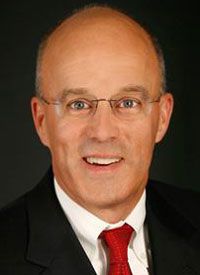Flat Rate Payment Pilots May Provide Guidance Toward Reform
A bundled payment model may signal the expansion of cost reforms in oncology treatment.
“Lee

Lee Newcomer, MD, MHA
Surging health care costs have brought attention to reform efforts aimed at improving delivery of care, and an announcement in December 2014, of a pilot project launched by MD Anderson and UnitedHealthcare for a bundled payment model may signal the expansion of such cost reforms in oncology treatment.1
“I think a bundled payment really enables good-quality care,” said Lee Newcomer, MD, MHA, vice president for oncology services at the UnitedHealthcare. “More isn’t always better. [MD Anderson] has mapped out all the processes, gotten rid of waste, and was able to offer us a bundle price that was less than our average price in the U.S. today.”2
Up to 150 patients of MD Anderson’s Head and Neck Center who are newly diagnosed with cancers of the salivary glands, oral cavity (including the mouth, lips, tongue, or soft palate), throat, or larynx may be enrolled in the pilot project. The center’s extensive, research-based clinical practices and protocols have begun planning for 8 bundled, fixed-price models.
Systematically eliminating unnecessary costs is no small task, according to Newcomer, because patient care may require surgery alone or more complicated treatments that include surgery, radiation, and chemotherapy.2
Flat rate payment models are the latest attempt to control ever-increasing costs of health care. The goal of these initiatives is to provide patients the opportunity to obtain the best possible outcome by delivering high quality, efficient, evidence-based care, according to Richard L. Schilsky, MD, chief medical officer for the American Society for Clinical Oncology.3He noted that the fee-for-service model widely used today rewards quantity, not quality, and has led to runaway cost.3Various attempts to control costs by Medicare, such as setting fees, providing a fixed pie, implementing annual spending limits, requiring preauthorization, and performing audits, have failed, according to Schilsky.3
However, accountable-care programs are gaining traction. Offering incentives for quality of care over quantity of services, Medicare’s Bundled Payments for Care Improvement (BPCI) program is well under way with over 500 participating providers.4
Commercial insurers and employers across the country have also entered into payment contracts with providers. Most agreements involve cardiovascular (13 providers) and orthopedic (16 providers) services.5
In Medicare’s BPCI system, organizations make payment arrangements for episodes of care (48 total) that include performance as well as financial accountability. The 4 payment models include 3 retrospective scenarios: acute care hospital stay only, acute care hospital stay plus post-acute care, and post-acute care only. The 4th scenario entails a prospective payment for acute care hospital stay only.
Retrospective (or “virtual”) bundling provides individual fee-for-service payments at standard Medicare reimbursement rates. After an episode concludes, Medicare compares the total reimbursement paid to the pre-established discounted bundle price and bills or reimburses for the difference. Under a prospective bundling model, the provider receives a single, lump sum payment from Medicare. If providers spend more, they suffer a loss. Both models arrive at the same conclusion: providers must reduce costs to below the bundled rate to be profitable.
Not all initiatives for bundled payments have been successful. A pilot program coordinated by Integrated Healthcare Association to adopt bundled payments for orthopedic procedures in California fell short of its goals due to low recruitment (just 35 orthopedic procedures in 3 years), regulatory uncertainty, administrative burden, and financial concerns.6Although the program failed to implement bundled payment plans in California, organizers hope to learn from their mistakes.
"Bundled payments have great promise for controlling health care costs, but thus far efforts to put the strategy in place on a wider scale have struggled," said Susan Ridgely, a senior policy analyst at RAND Corporation and lead author on the study. "We've learned lessons from the early setbacks, but more work still needs to be done to realize the potential of this model of payment."
Ridgely lists several recommendations, including keeping the bundle definitions simple, implementing appropriateness criteria, managing distribution of risk between payers and providers, implementing technical solutions to process claims, and changing benefit design to steer patients to participating providers.
Prospective payment models shift risk from payers to providers. UnitedHealthcare notes that MD Anderson doctors will benefit financially by assuming more risk, motivating the center to streamline health care, improving quality, and eliminating bureaucratic inefficiencies.
The shift in risk becomes especially burdensome for smaller practices in light of escalating chemotherapy costs, but not all bundling plans include drugs. With the shift in rewards from volume to efficiency, risk shifts from over- to under-utilization, so the plans must have strong quality measurement components.
“The best way for us to understand and determine how episode-based pricing in cancer care works is to evaluate it,” said Thomas Feeley, MD, head of anesthesiology and critical care at MD Anderson. “We have the right processes, accounting systems, people and collaborator in UnitedHealthcare to take this step.”7
References
- Business Wire. MD Anderson, UnitedHealthcare Launch New Cancer Care Payment Model. http://www.mdanderson.org/education-and-research/research-at-md-anderson/cancer-care-innovation/index.html. Accessed December 29, 2014.
- Star Tribune. UnitedHealth launches pilot payment program at MD Anderson Cancer Center. http://www.startribune.com/business/285690391.html. Accessed December 29, 2014.
- Schilsky, Richard L. Cancer Care Delivery Reform [PowerPoint slides]. Retrieved from National Coalition for Cancer Survivorship: http://www.canceradvocacy.org Schilsky-Cancer-Care-Delivery-Reform.ppsx. Accessed December 29, 2014.
- Centers for Medicare & Medicaid Services. CMS Announces New Initiative to Improve Care and Reduce Costs for Medicare. http://www.cms.gov/Newsroom/MediaReleaseDatabase/Press-releases/2013-Press-releases-items/2013-01-31.html. Accessed December 29, 2014.
- The Advisory Board Company http://www.advisory.com/research/health-care-advisory-board/resources/2013/commercial-bundled-payment-tracker. Accessed December 29, 2014.
- Rand Corporation: http://www.rand.org/news/press/2014/08/04.html. Accessed December 29, 2014.
- The Dallas Morning News. Landers: Curbing the Cost of Cancer Care. http://www.dallasnews.com/business/columnists/jim-landers/20141215-landers-curbing-the-cost-of-cancer-care.ece. Accessed December 29, 2014.